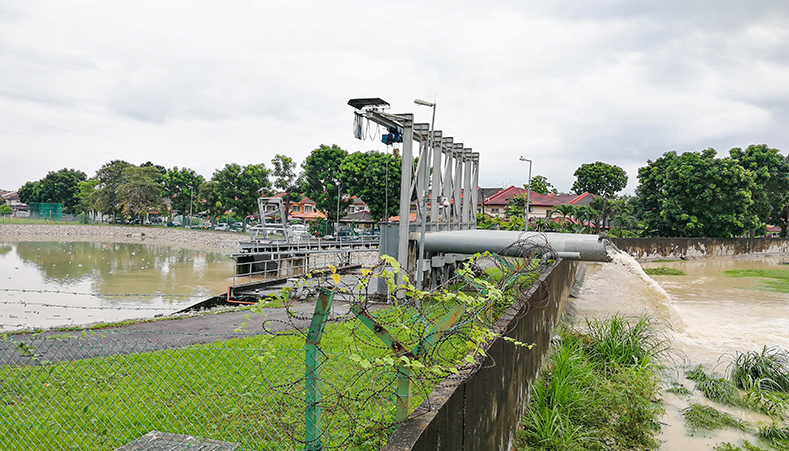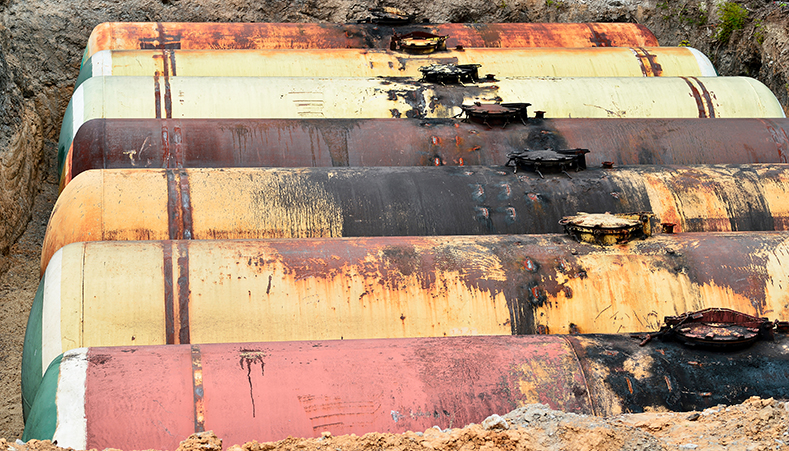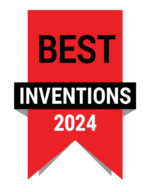High TPH Concentrations Treated Using PersulfOx® and ORC® Advanced
Future Site of Stormwater Retention Ponds Remediated with ISCO, Enhanced Aerobic Biodegradation
Project Highlights
- Initial treatment with aerobic bioremediation effectively removed 60% of site contamination.
- PersulfOx® and ORC® Advanced were used to treat two remaining hot spot areas.
- Site closure is pending additional groundwater monitoring.
- Contamination concentrations must be reduced to meet stringent groundwater quality standards.

Project Summary
This site is a former commercial facility in the Southeast with high TRPH contaminant impacts to soils and groundwater. The property is currently vacant and the state department of transportation plans to create a stormwater retention pond on site. However, contaminant concentrations in groundwater need to be reduced to meet stringent groundwater quality standards before any construction can begin.
The plume was first treated via enhanced aerobic bioremediation with ORC Advanced, which effectively removed over 60% of the dissolved-phase contamination within 18 months. In two hot spot areas, residual contamination in the smear zone continued to cause impacts to groundwater. A follow-up treatment combining in situ chemical oxidation and enhacned aerobic bioremediation was employed. PersulfOx and ORC Advanced were used to bring this site towards closure by effectively treating these two hot spot areas. Initial sampling results 30 days after treatment showed attainment of groundwater quality standards.
Remediation Approach
ORC Advanced was injected over 60 direct-push locations across two plume areas. A year and a half post-application, two remaining hot spot areas with residual capillary fringe contamination had caused continued issues. PersulfOx and ORC Advanced were used to bring this site towards closure by effectively treating these two hot spot areas.
Technology Description
ORC Advanced is a proprietary formulation of food-grade, calcium oxy-hydroxide that produces a controlled-release of molecular oxygen for periods of up to 12 months upon hydration.
PersulfOx is a sodium persulfate-based chemical oxidation technology which destroys both hydrocarbon and chlorinated solvent-type contaminants in the subsurface. PersulfOx contains a built-in catalyst which activates the persulfate component and generates contaminant-destroying free radicals without the need for the addition of a separate activator.
RegenOx® Excavation Application Treats Groundwater Contamination
80% TPH Concentration Reduction at California DoD Facility
Project Highlights
- Source removal and RegenOx® ISCO application reduce contamination levels to clean-up standards
- Horizontal piping network installed as contingency plan for additional remediation
- 80% reduction in groundwater concentrations observed

Project Summary
The project site is a former Department of Defense (DoD) fuel dispenser facility in Northern California where past corrective measures included AST/UST removal, soils excavation and groundwater monitoring. Sample results indicated continued elevated concentration levels of TPH-G, TPH-D and TPH-mo within a defined area near the former USTs. The treatment approach included additional excavation and in situ chemical oxidation (ISCO) application via RegenOx mixed into saturated zone. Quarterly sampling indicated an 80% reduction in groundwater concentration levels post treatment; which met the corrective action cleanup levels for TPH.
Remediation Approach
The selected contractor excavated, managed and disposed of impacted soils to depths of nine feet over the two defined treatment areas. RegenOx Part A (oxidizer) and Part B (silica gel activator solution) were placed in the saturated zone and mixed in with the excavator bucket to 3 feet below the excavation bottom. Prior to backfill and compaction, a horizontal piping network was installed to serve as a contingency plan in the event that any additional in situ and/or bioremediation remediation was required. Regenesis assisted the client with the horizontal piping network design which was incorporated into the bid specifications. This site area has been submitted for closure and with continued quarterly monitoring.
Technology Description
RegenOx is an advanced chemical oxidation technology that destroys contaminants through powerful, yet controlled chemical reactions and not through biological means. This product maximizes in situ performance while using a solid alkaline oxidant that employs a sodium percarbonate complex with a multi-part catalytic formula.
Acetone and Petroleum Hydrocarbons Treated at Active Industrial Facility
Combined ISCO/Bioremediation Treatment Approach Reduces Contamination Levels
Project Highlights
- Acetone concentrations pre-remedation were as high as 54,000 μg/L
- Site access agreement required that existing site operations could not be interrupted for construction
- Site water was not allowed to be used therefore all water had to be trucked in and a separate water permit to access city water from fire hydrants was required
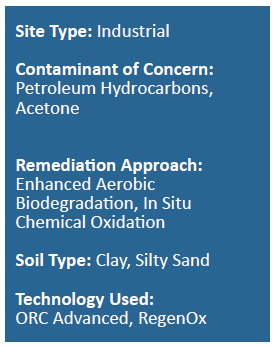
Project Summary
A former industrial facility in northern California operated as a gas manufacturing plant from the early 1900s until it was decommissioned in 2001 and sold. The property is currently leased by a bottled water distribution facility.
At this facility, acetone was used extensively in acetylene manufacturing. The acetone was stored on-site in underground storage tanks (UST) but no evidence of leaking acetone USTs was found.
However, high concentrations of acetone – a pre-remediation maximum of 54,000 micrograms per liter (μg/L) were found in one area of the site. Other dissolved chemicals of concern (COC) include gasoline and gasoline-range petroleum hydrocarbons from former USTs such as benzene, toluene, ethylbenzene and xylenes (BTEX).
The extent of contamination in the early 1990s extended to large portions of the site. A pump and treat system was used on-site in 2005, however contamination persisted. Contamination approximately 12 feet below ground surface was detected within the soil. A remediation plan using both ORC® Advanced and RegenOx® was used to treat the remaining contamination.
The site access agreement for this project required that existing site operations could not be interrupted for construction. In order to minimize disturbance to tenants and work within these constraints, all drilling field work was performed on weekends. Site water was not allowed to be used therefore all water had to be trucked in and a separate water permit to access city water from fire hydrants was required. In addition, multiple drill rigs and support vehicles operated within a small area, increasing logistical and safety concerns.
Remediation Approach
A mixture of 6,500 pounds of RegenOx and 3,000 pounds of ORC Advanced was injected at 45 locations using multiple direct-push drill rigs. The injection points were designed in a grid pattern with a nominal 15-foot spacing between injection points, but more densely placed in the area of highest contaminant concentration. Benzene concentrations in groundwater have stabilized at about 10 μg/L and acetone concentrations have stabilized at about 1,600 μg/L. Post-treatment monitoring results show that all the COCs in the treatment area have consistently remained below health-based cleanup levels since the treatment was applied.
Technology Description
Advanced Formula Oxygen Release Compound (ORC Advanced®) is a proprietary formulation of food-grade, calcium oxy-hydroxide that produces a controlled-release of molecular oxygen for periods of up to 12 months upon hydration.
RegenOx is an advanced chemical oxidation technology that destroys contaminants through powerful, yet controlled chemical reactions and not through biological means. This product maximizes in situ performance while using a solid alkaline oxidant that employs a sodium percarbonate complex with a multi-part catalytic formula.
Open Excavation Treatment at Former NJ Service Station
RegenOx® and ORC® Advanced Pellets Remediate Petroleum Hydrocarbon Contamination
Project Highlights
- Former service station contaminated with BTEX levels measuring 11 ppm in groundwater and soil impacts removed through excavation
- Combined remedy to treat the open excavation with both in situ chemical oxidation and enhanced aerobic bioremediation technologies
- RegenOx and ORC Advanced Pellets technologies are compatible/non-corrosive with underground infrastructure and utilities infrastructure in the subsurface

Project Summary
A former service station in New Jersey was contaminated with high levels of BTEX (measuring 11 ppm in groundwater pre-treatment). Due to significant amounts of contaminated soil mass remaining at the former service station, an excavation was proposed by the environmental consultant. RegenOx and ORC Advanced Pellets were applied to the open excavation to chemically oxidize remaining saturated impacts and to promote enhanced aerobic biodegradation of petroleum hydrocarbons in the dissolved phase. Both of these technologies utilize alkaline chemistry (pH > 8), which is non-corrosive to nearby public utilities and the underground infrastructure at the service station.
Remediation Approach
RegenOx and ORC Advanced were co-applied into an open excavation at the former service station site. The excavation extended approximately four feet into the saturated zone. Because the excavation was limited by physical constraints, RegenOx, a chemical oxidant, was applied to the base of the excavation to oxidize and desorb residual petroleum mass from the soil. ORC Advanced Pellets were co-applied to provide a slow release of oxygen (up to 12 months longevity) that promotes enhanced aerobic biodegradation of petroleum hydrocarbons. In total, 2,000 pounds of RegenOx and 882 pounds of ORC Advanced Pellets were co-applied to the 2,600 square foot excavation area.
Technology Description
The advanced formulation of the Oxygen Release Compound (ORC Advanced) is a proprietary formulation of food-grade, calcium oxy-hydroxide that produces a controlled-release of molecular oxygen for periods of up to 12 months upon hydration. The pelletized form of ORC Advanced were designed to improve safety and handling for excavation applications.
RegenOx is an advanced chemical oxidation technology that destroys contaminants through powerful, yet controlled direct oxidation and free-radical reactions. This product maximizes in situ performance through the use of a solid alkaline oxidant (a sodium percarbonate complex) and a multi-part catalyst. These oxidation reactions do not inhibit natural bacterial populations and are compatible with biological treatment methods.
Cost-Effective Remediation Plan Implemented at Active Texas Dry Cleaner
3-D Microemulsion® Reduces Chlorinated Solvent Contamination to Clean-Up Standards
Project Highlights
- Dual-phase extraction used to treat high level PCE in the source area.
- Enhanced Anaerobic Bioremediation selected as a cost-effective approach to treating migrating contamination.
- Majority of contamination reduced to clean-up standards; two low-level VC areas remain above desired limits.

Project Summary
Dry cleaning operations resulted in a PCE release at a Texas dry cleaner. PCE concentrations at high at 95 mg/L were observed on-site. Aggressive clean-up measures were used in the form of dual-phase extraction of DNAPL and solvents in the source area. This resulted in nearly a two order-of-magnitude reduction in PCE concentrations in certain source wells. The second clean-up phase included expanding the system to treat contamination that had migrated out of the source area into the periphery of the groundwater plume.
Remediation Approach
Due to a limited budget for remediation, a cost-effective anaerobic bioremediation approach was selected due to the desire for a long-lasting solution that could also achieve low concentrations. 3-D Microemulsion and HRC Primer were injected along the migration centerline of the plume extending from just outside the source area to the toe of the plume. A second smaller treatment event was conducted in the vicinity of the former source area.
One year post-injection all solvent concentrations have dropped below clean-up standards with the exception of two low-level contamination areas. Recent treatment of the source area is starting to result in similar trends although there is not enough data yet to track remediation progress of the second injection event.
However, biostimulation alone through the addition of 3-D Microemulsion and HRC Primer appears to be very effective. Ongoing monitoring will occur followed by initiation of closure monitoring once all critical wells reach target levels.
Technology Description
3-D Microemulsion is an engineered electron donor material that offers a novel 3-stage electron donor release profile, pH neutral chemistry and is delivered on-site as a factory-emulsified product.
HRC Primer is a less viscous version of the standard Hydrogen Release Compound (HRC) product. It is a thinner, water-like compound that is typically injected into an aquifer where it releases lactic acid at a rate faster than standard HRC (several weeks), but at a slower, more controlled rate than dispersing aqueous simple sugar solutions or straight lactic acid (several days).
Combined Remedies Treat BTEX Contamination on Government Property
Ontario, Canada Site Remediated with ORC® Advanced and RegenOx®
Project Highlights
- In Situ Chemical Oxidation (ISCO) and Enhanced Biodegradation used post-excavation to treat residual contamination.
- Extensive site mapping conducted with membrane interface probe (MIP) to detect distinct zones of higher mass contamination.
- 95% reductions seen in dissolved phase petroleum hydrocarbon contamination.
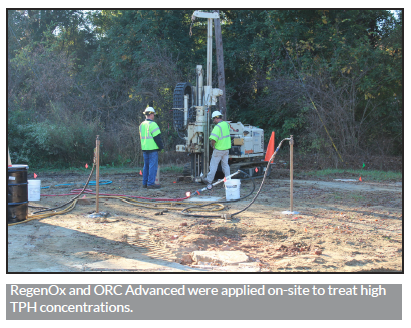
Project Summary
A large public works property in Ontario, Canada was contaminated with TPH. Approximately 5,000 gallons of fuel was released into the subsurface primarily due to fuel theft that had taken place on-site. Due to significant volumes of free-product, an excavation occurred followed by skimming activities from 2005-2010. Through extensive site evaluation, it was determined that there was a need for further mass reduction using ISCO.. RegenOx® ISCO was selected for use in the heavily and moderately impacted areas. Enhanced aerobic biodegradation using ORC® Advanced was selected for use in the dissolved-phase areas downgradient from the source. Overall, 96% reductions were seen in dissolved phase petroleum hydrocarbon concentrations.
Remediation Approach
Membrane interface probe (MIP) data was collected and proved to be integral for the remediation design and implementation. Distinct zones with high mass were present on-site and detected through the probe. RegenOx and ORC Advanced were applied via direct-push injections. Approximately 150,000 pounds of RegenOx and 45,000 pounds of ORC Advanced were applied over several injections. Higher concentrations of RegenOx were applied into the vertical zones of higher contamination to improve overall product performance.
Technology Description
Advanced Formula Oxygen Release Compound is a proprietary formulation of food-grade, calcium oxy-hydroxide that produces a controlled-release of molecular oxygen for periods of up to 12 months upon hydration.
RegenOx is an advanced chemical oxidation technology that destroys contaminants through powerful, yet controlled chemical reactions and not through biological means. This product maximizes in situ performance while using a solid alkaline oxidant that employs a sodium percarbonate complex with a multi-part catalytic formula.
PersulfOx® Treats Gasoline Tanker Truck Spill Site
Pilot Study Moved to Full-Scale Application to Remediated Benzene and TPH-G Contamination
Project Highlights
- Pilot study moves to full-scale application after large contamination concentration decrease resulting from in situ chemical oxidation (ISCO).
- High-volume, direct-injection of PersulfOx® ISCO distributes reagent beneath highway.
- ORC Advanced applied to edge of plume to prevent further migration.
- The average reductions of benzene or TPH-G were 83% and 79% respectively.
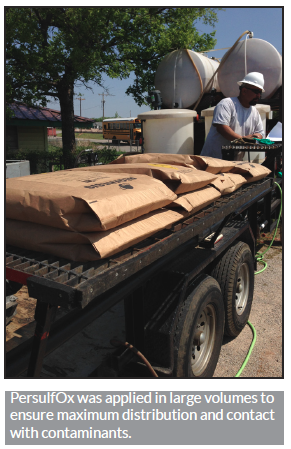
Project Summary
A gasoline tanker truck rollover occurred in Ringling, Oklahoma resulting in a benzene and TPH-G contamination. A pilot study using PersulfOx ISCO was conducted with up to 98% contamination reduction observed. Upon successful completion of the pilot study, a full-scale application was approved. A series of full-scale ISCO applications commenced to achieve significant knockdown of benzene and TPH-G concentrations at the site.
Remediation Approach
Full-scale PersulfOx injections were focused along a run-off ditch on the east side of the highway where contamination reached the groundwater during the initial spill and also downgradient on the west side of the highway where contamination had migrated.
The intent of injections on the east side of the highway were designed to address source contamination. These injections were also designed to treat the contamination beneath the highway. PersulfOx migrated through the aquifer under the influence of large direct-push injection volumes and a strong underlying groundwater gradient and natural slope of the lower confining bedrock.
Two PersulfOx injections have been completed approximately one month apart while an application of ORC Advanced also was applied in the distal part of the plume to prevent further spreading of BTEX and TPH.
The average reductions of benzene or TPH-G were 83% and 79% respectively. These are encouraging results and indicate beneficial oxidation and mass reduction of fuel hydrocarbon contamination. Ongoing monitoring will determine if additional applications are needed to reach remedial goals.
Technology Description
Advanced Formula Oxygen Release Compound (ORC Advanced®) is a proprietary formulation of food-grade, calcium oxy-hydroxide that produces a controlled-release of molecular oxygen for periods of up to 12 months upon hydration.
PersulfOx is a sodium persulfate-based chemical oxidation technology which destroys both hydrocarbon and chlorinated solvent-type contaminants in the subsurface. PersulfOx contains a built-in catalyst which activates the persulfate component and generates contaminant-destroying free radicals without the need for the addition of a separate activator.
Remediation at Multiple Service Stations using Badger Application System
RegenOx® Applied to Three Long Island Sites Contaminated with High BTEX Levels
Project Highlights
- BTEX levels higher than 20 mg/L observed on-site.
- Badger Injection System allowed for high volume applications of up to 700 gallons per injection point.
- In Situ chemical oxidation (ISCO) using 56,400 pounds of RegenOx® was used at three service station sites.
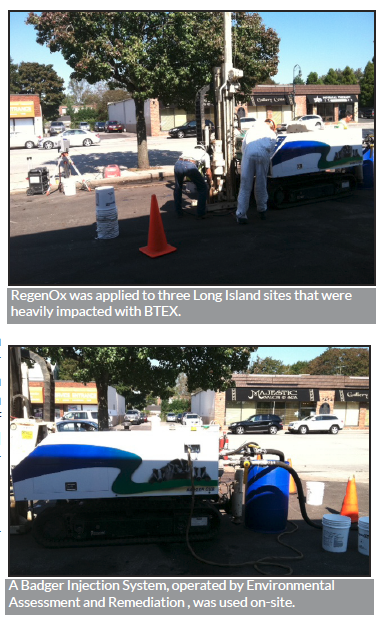
Project Summary
Several service station sites in Long Island, N.Y. were contaminated with high levels of BTEX. In heavily impacted areas, BTEX levels were higher than 20 mg/L. RegenOx was applied to the sites using the Badger Injection System, which is operated by Environmental Assessment and Remediation (EAR). The Badger injection process is used to deliver large volumes of reagent to targeted treatment zones. The objective is to obtain widespread distribution of reagent. Typical injection volumes are 500 to 700 gallons per injection point.
Remediation Approach
The Long Island sites range in size from 600-square-feet to over 4,000-square-feet.
Injection Amounts:
- Site 1 – 30,000 pounds of RegenOx; 4 Injection Events
- Site 2 – 24,000 pounds of RegenOx; 3 Injection Events
- Site 3 – 2,400 pounds of RegenOx; 2 Injection Events
Technology Description
RegenOx is an advanced chemical oxidation technology that destroys contaminants through powerful, yet controlled direct oxidation and free-radical reactions. This product maximizes in situ performance through the use of a solid alkaline oxidant (a sodium percarbonate complex) and a multi-part catalyst. These oxidation reactions do not inhibit natural bacterial populations and are compatible with biological treatment methods.
Regulatory Goals Met in 30 Days in Complex Industrial Dry Cleaner Plant Remediation
Project Highlights
- PCE contaminant concentrations met remediation goals within 30 days post-application
- No rebound post-application
- Remediation goals met for site closure submittal
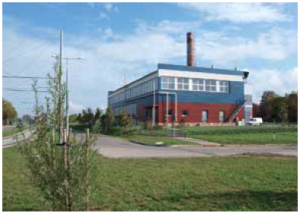
Project Summary
An industrial dry cleaning plant in West Allis, Wisconsin was equipped with multiple underground storage tanks (USTs) which stored the degreasing agent perchloroethylene (PCE). The UST releases date back to 50 years and created a treatment area of approximately 4,500 square feet. An in situ, combined remedies treatment approach was implemented onsite using a range of reagents including PlumeStop®, RegenOx®, Hydrogen Release Compound (HRC®) and BioDechlor INOCULUM Plus (BDI® Plus). This site was planned for future development, consequently the remediation approach was designed to achieve site closure by removing the residual source in the vadose zone and treating the deep groundwater plume.
Remediation Approach
Starting in the residual source area, in situ chemical oxidation (ISCO) was applied via soil mixing down to a depth of 7 ft. below ground surface. The ISCO program using RegenOx was designed to treat a total of 140 tons of PCE-impacted clay soil with initial concentrations measuring 169 mg/kg and a remediation goal of <14 mg/kg. To address the deep groundwater plume with PCE concentrations as high as 13,800 ppb, fast-acting, PlumeStop was applied through a series of deep injection wells approximately 80 to 95 ft. below ground surface. The use of PlumeStop allows remediation practitioners to quickly reduce concentrations over a wide-area with the long-term assurance of biodegradation. HRC and BDI Plus were co-applied with PlumeStop to enhance the biodegradation process.
Technology Description
RegenOx is an advanced chemical oxidation technology that destroys contaminants and maximizes in situ performance while using a solid alkaline oxidant that employs a sodium percarbonate complex with a multi-part catalytic formula.
PlumeStop is an innovative in situ remediation technology designed to rapidly reduce contaminant concentrations, stop migrating plumes, eliminate contaminant rebound, achieve stringent clean-up standards, and treat back-diffusing contaminants.
HRC is a controlled release, electron donor material, highly efficient for the production of dissolved hydrogen to fuel anaerobic biodegradation processes in soil and groundwater.
Bio-Dechlor INOCULUM Plus is a species of Dehalococcoides sp. (DHC), enriched to increase its ability to rapidly dechlorinate contaminants during in situ bioremediation processes.
Results
The ISCO application of RegenOx, and combined approach using HRC, BDI Plus and PlumeStop rapidly reduced contaminant concentrations to achieve the remediation goal in just 30 days post-application. As a result, the client has submitted for site closure. Using an innovative combined remedies approach provides environmental remediation professionals with an effective solution for treating sites that present multiple challenges including hard to treat contaminants, sites with lengthy history of impacted soils, difficult geologies, and time constraints.
Free-Phase Hydrocarbons Significantly Reduced on Historic Spill Site Within Four Months
Project Highlights
- PetroCleanze™ applications combined with High Vacuum Dual-Phase
Extraction (HVDPE) reduced site contaminant mass and totally eliminate
free-phase hydrocarbons within four months - TPH concentrations reduced by over 97% at key monitoring well
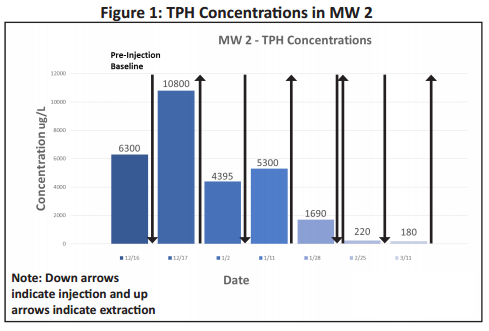
Project Summary
A leak from an above ground diesel tank caused groundwater contamination, including free-phase and dissolved hydrocarbons, and significant bound hydrocarbon mass at this manufacturing site. Remediation efforts conducted for nearly a decade included excavation, freephase hydrocarbon recovery, groundwater treatment, bio-venting, high-vacuum dual-phase extraction (HVDPE), and chemical oxidation. However, a free-phase hydrocarbon layer still existed over much of the site as indicated in key monitoring wells.
REGENESIS® recommended the use of PetroCleanze to desorb bound hydrocarbons from the plume area, which was the source of the reoccurring freephase layer. A design was developed that included a regimen of PetroCleanze injections and HVDPE events to desorb and recover the bound hydrcarbons still existing on the site, which would then be recovered by use of the existing HVDPE system.
A total of 107,000 gallons of PetroCleanze was applied through 57 injection points in a grid pattern. Four injection events occurred over the course of four months at depths of 19-27 feet below ground surface. HVDPE was conducted between injection events to recover desorbed hydrocarbon mass.
Technology Description
PetroCleanze is a customized formulation of the widely used RegenOx in situ chemical oxidation technology. The primary function of RegenOx PetroCleanze is to increase the desorption rates of hydrocarbons bound in saturated soil and make them available for more efficient and rapid treatment using a range of enhanced recovery technologies.
Results
Following treatment of the site with PetroCleanze, combined with HVDPE, groundwater hydrocarbon contamination was significantly reduced, as evidenced by a 97% reduction at key monitoring well MW-2 (See Figure 1). The consulting firm leading the project is currently performing quarterly monitoring ahead of petitioning for site closure.

 Americas
Americas Europe
Europe Français
Français Deutsch
Deutsch Italiano
Italiano Español
Español